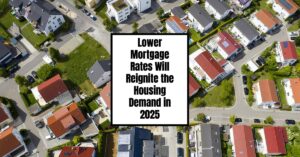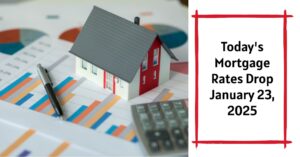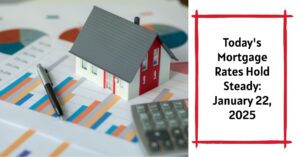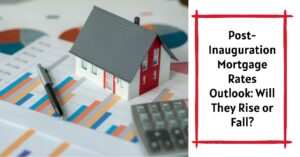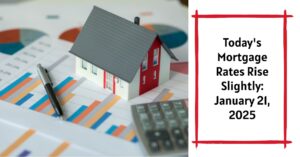Could the housing market regain its momentum in 2025? Mortgage rates have historically been a key driver of demand, and experts are forecasting a significant decline from the elevated rates of 2023 and early 2024. Many homebuyers, delayed by financial strain or affordability challenges, might find themselves finally ready to jump into the market when mortgage rates fall.
The phrase “lower mortgage rates could draw buyers back to the housing market in 2025” is more than speculation—it’s a reflection of cyclical economic trends, consumer behavior, and policy effects.
The housing market, however, doesn’t operate in a vacuum. Whether the optimism of lower mortgage rates transforms into actual affordability or rekindled demand depends on several other factors, including tight inventory, potential price increases, and the broader economic environment.
Lower Mortgage Rates Will Reignite the Housing Demand in 2025
Key Takeaways
- Mortgage rates likely to drop below 6.3% by 2025, as predicted by industry experts, making homeownership more accessible to buyers .
- Inventory challenges persist, but new builds could address the gap: Builders may shift focus to affordable housing solutions to cater to fresh demand.
- Slower home price appreciation: A projected average increase of just 2% in home prices for 2025 compared to 2024 provides more stability for buyers (CoreLogic).
- Economic factors to watch: Inflation, Federal Reserve interest rate policies, and wage growth will heavily influence the trajectory of the housing market.
- Increased demand vs. housing supply constraints: A market imbalance could drive up competition, offsetting some affordability gains.
Why Falling Mortgage Rates Matter So Much
Mortgage rates represent a substantial portion of a household’s financial obligations when purchasing a home. For context, when rates increased beyond 7% in late 2023, monthly payments for a typical borrower shot up significantly, deterring many prospective buyers. Lowering these rates in 2025 has the potential to make a massive difference in affordability.
Consider this example: On a $400,000 home purchase with 20% down over a 30-year term, the effect of varying interest rates plays out as follows:
| Mortgage Rate (%) | Monthly Payment (Principal + Interest) | Annual Payment | Total Cost Over 30 Years |
|---|---|---|---|
| 7.0% | $2,661 | $31,932 | $957,960 |
| 6.5% | $2,528 | $30,336 | $910,080 |
| 6.0% | $2,398 | $28,776 | $863,280 |
| 5.5% | $2,271 | $27,252 | $818,520 |
| 5.0% | $2,147 | $25,764 | $773,520 |
This table highlights the dramatic savings for homeowners as rates drop. A lower rate translates into reduced monthly payments—which, for many, is the difference between being able to afford a home or needing to continue renting.
Current Challenges in the Housing Market
1. The Inventory Shortage
While lower mortgage rates could make housing more affordable, inventory remains a significant roadblock. Experts have coined the term “lock-in effect” to describe the reluctance of current homeowners to sell their properties. Many homeowners locked in fixed-rate mortgages before 2022 with historically low rates of 3–4%. Giving up those rates to take on a new, more expensive mortgage deters sellers from entering the market, shrinking supply.
According to TheStreet, the inventory issue is expected to persist into 2025 unless policymakers or builders step in with bold solutions such as incentives for new construction or tax breaks for selling.
2. Rising Buyer Competition
Falling mortgage rates could bring a flood of pent-up demand into the market, especially among first-time buyers. Young professionals, millennials, and Gen Z buyers have been battling affordability hurdles for years. With rates lowering in 2025, they may become more motivated.
However, increased competition creates conditions for bidding wars, which drive up prices. In particularly desirable areas—urban hubs, high-growth suburbs, or regions with strong job markets—competition could outpace the inventory relief provided by new builds.
3. Housing Prices Stabilizing
The news isn’t all grim on the pricing front. While prices have surged in the past ten years, CoreLogic forecasts a reduced growth rate of around 2% for 2025 home prices. Moderating price increases could help offset any competitive bidding seen in popular markets (Bankrate).
Forecast for First-Time Buyers
First-time homebuyers have faced enormous challenges, including rising rents, limited savings, and inflated housing prices. A lower interest rate environment could significantly benefit this group.
Why 2025 Looks Promising for First-Time Buyers:
- Reduced monthly payments, lowering the entry barrier.
- FHA and VA loan limits could increase in response to rising home prices, enabling buyers to access financing for more expensive homes.
- Stabilizing home prices make market entry less risky, even as inflation concerns continue.
The Risks:
- High competition in low- and mid-tier housing markets could frustrate potential buyers.
- In regions where demand surges, affordability gains from lower interest rates may be diminished.
Economic and Federal Factors: What You Need to Know
The direction of the economy and Federal Reserve policy decisions will be pivotal in shaping 2025's housing market. Here are some critical areas to monitor:
- Federal Reserve Interest Rate Policies: Lowering benchmark federal rates means reduced borrowing costs. Experts predict that if the Fed pivots toward rate cuts in 2024, mortgage rates could follow in 2025.
- Wage Growth vs. Inflation: Wage growth needs to keep pace with inflation to ensure that buyers can make down payments and keep up with housing market competition.
- Global Economic Conditions: Issues like international trade, supply chain disruptions, and geopolitical tensions could ripple into construction costs and home prices, even in a rate-friendly environment.
The Role of New Construction in Alleviating Supply Issues
If current homeowners continue to hold onto their low-rate mortgages, new construction might be the solution to bridge demand and supply. Builders could focus on building smaller homes at affordable price points to cater to first-time buyers.
What Experts Say About Housing Starts:
- Housing inventory could rise roughly 8–10% in 2025 if construction of entry-level homes increases by 15%, as forecasted by Real Estate Consulting (US News).
- Urban areas and emerging “15-minute cities” might see the highest concentration of affordable housing projects.
Will 2025 Be a Seller's or Buyer's Market?
The balance of power between buyers and sellers depends largely on regional trends. While falling rates suggest a buyer-friendly climate, limited inventory could keep sellers in a strong position in some metros. The market could move toward equilibrium, but only if economic conditions remain stable.
Conclusion: A Glimmer of Hope for 2025
The prediction that lower mortgage rates could draw buyers back to the housing market in 2025 offers hope to many who’ve been sitting on the sidelines for years. Whether you're a first-time buyer, an investor, or a seller, preparing early for these shifts will be crucial.
With mortgage rates set to decline, inventory poised for modest growth, and price appreciation slowing, the pieces are falling into place for a stronger housing market—albeit one with its share of challenges.
Work with Norada in 2025, Your Trusted Source for
Turnkey Real Estate Investing
Discover high-quality, ready-to-rent properties designed to deliver consistent returns.
Contact us today to expand your real estate portfolio with confidence.
Contact our investment counselors (No Obligation):
(800) 611-3060
Recommended Read:
- NAR Predicts 6% Mortgage Rates in 2025 Will Boost Housing Market
- Housing Market Forecast for the Next 2 Years: 2024-2026
- Housing Market Predictions for Next Year: Prices to Rise by 4.4%
- Housing Market Predictions for 2025 and 2026 by NAR Chief
- Real Estate Forecast Next 5 Years: Top 5 Predictions for Future
- Is the Housing Market on the Brink in 2024: Crash or Boom?
- 2008 Forecaster Warns: Housing Market 2024 Needs This to Survive
- Real Estate Forecast Next 10 Years: Will Prices Skyrocket?
- Housing Market Predictions for Next 5 Years (2024-2028)
- Housing Market Predictions 2024: Will Real Estate Crash?
- Housing Market Predictions: 8 of Next 10 Years Poised for Gains
- Trump vs Harris: Which Candidate Holds the Key to the Housing Market (Prediction)
